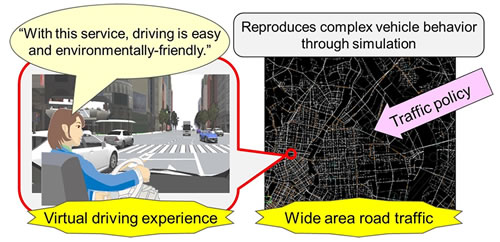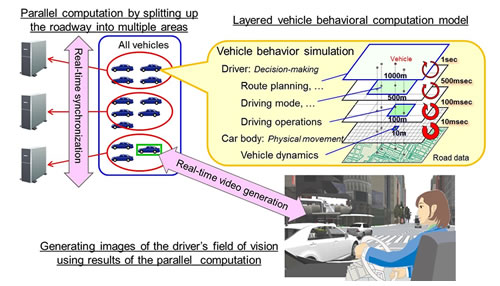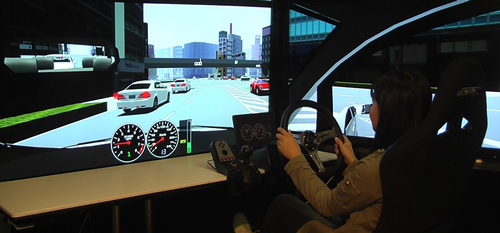Kawasaki, Japan, December 06, 2010
Fujitsu Laboratories Limited today announced the development of a wide-area traffic simulation system that reproduces in real-time the behavior of tens of thousands of vehicles located across a wide area of roadway, and enables users to virtually ride inside of one of the vehicles and drive it. The new simulator makes it possible to verify in advance the effectiveness of a variety of traffic policies designed to improve traffic flow. In addition, through virtual driving experience, users can evaluate the effectiveness of these policies and discover problem areas from the actual driver's perspective, making it possible to design appropriate policies that are tailored to the traffic conditions. These efforts will support the creation of a transportation system that is safe, comfortable, and environmentally-friendly, in addition to being acceptable to users.
 Figure 1: Newly-developed wide-area traffic simulator featuring virtual driving experience
Figure 1: Newly-developed wide-area traffic simulator featuring virtual driving experience
Larger View (104 KB)
Background
Improving the flow of traffic is becoming a significant challenge in preventing traffic congestion and accidents, as well as in reducing automobile-related CO2 emissions. A variety of new traffic policies are under consideration to resolve these issues, including car navigation system-enabled VICS(1) services, the installation of electronic toll collection systems, and adjustments to highway toll fees, in addition to advanced notification of signal information and road pricing(2).
The effectiveness of these policies varies greatly depending on the location and conditions under which they are implemented, and it is necessary to verify in advance the most effective method for each possible scenario. In many cases, however, it is difficult to conduct this verification on the actual roads, which has led to the development of traffic simulators that can evaluate the effectiveness and impact of traffic policies in a virtual environment. Furthermore, to determine the impact of these traffic policies on actual drivers, it will be necessary to evaluate them through driving.
Technological Challenges
In order for a virtual driving experience to accurately evaluate the effectiveness of traffic policies and discover problem areas, researchers must reproduce in real-time the detailed behavior of thousands to tens of thousands of vehicles driving on city streets within an area of at least a few kilometers in radius. Accomplishing this, however, requires a massive volume of calculations related to driver behavior, including route planning, driving operations, the physical movement of the vehicles, and interaction between vehicles. As a result, existing traffic simulators have been unable to perform these calculations in real-time, making the implementation of a virtual driving experience difficult.
Newly-developed Technology
Fujitsu Laboratories has developed technology that simulates in real-time the detailed behavior of tens of thousands of vehicles located across a wide area of roadway. At the same time, by generating 60 frames/second of video displaying the road from the driver's viewpoint, users can virtually ride inside of one of the vehicles.
Real-time simulation of the behavior of tens of thousands of vehicles involves splitting up the roads from a wide region into multiple areas, and calculating each of these areas in parallel. As part of these computations, real-time calculations must also be performed to compute the migration of vehicles across area boundaries, as well as the interaction between vehicles. For computing driver behavior, route planning, driving operations and the physical movement of vehicles in real-time, the simulator calculates them based on a layered vehicle behavioral computation model and changes the volume and frequency of calculations for each layer. (Figure 2).
 Figure 2: Technology to enable virtual driving experience employing the new wide-area traffic simulator
Figure 2: Technology to enable virtual driving experience employing the new wide-area traffic simulator
Larger View (110 KB)
Furthermore, the system collects computational results needed to generate an image of the driver's field of vision 60 times per second, and then produces a video in real-time. This enables users to virtually experience what it is like to drive on a wide area of roadway (Figure 3).
 Figure 3: Environment for virtual driving experience
Figure 3: Environment for virtual driving experience
Larger View (209 KB)
Results
The newly developed technology simulates traffic policies put into place across a wide area of roadway, thereby allowing researchers to evaluate the policies through virtual driving experiences. This will support the creation of a transportation system that is safe, comfortable, and environmentally-friendly, in addition to being acceptable to users.
As an example transportation policy test case, within a 10-kilometer radius area of Tokyo, Fujitsu Laboratories performed a simulation of - and evaluated through a virtual driving experience - a service that notifies drivers of the advisory speed at which they should pass through street lights while doing their best not to accelerate or decelerate, as a way of reducing CO2 emissions. As a result, researchers learned that the ease of driving and the impact of the service on reducing CO2 depends on the method and timing of the notifications. By improving the method of notification, Fujitsu Laboratories was able to quickly verify a highly-effective service for making driving easier.
Future Developments
Fujitsu Laboratories plans to use the simulator to evaluate traffic guidance and other systems that employ traffic status sensing and telematics(3) technologies, thereby helping to make such services more practical. In addition, the company aims to expand the regional scope of simulations, as well as expand the range of services the simulation can evaluate in order to apply the simulations in evaluating traffic policies at a regional level or for city or prefectural governments.
![]() Phone: +(81)78-934-2429
Phone: +(81)78-934-2429![]() E-mail: itssim-press@ml.labs.fujitsu.com
E-mail: itssim-press@ml.labs.fujitsu.com

